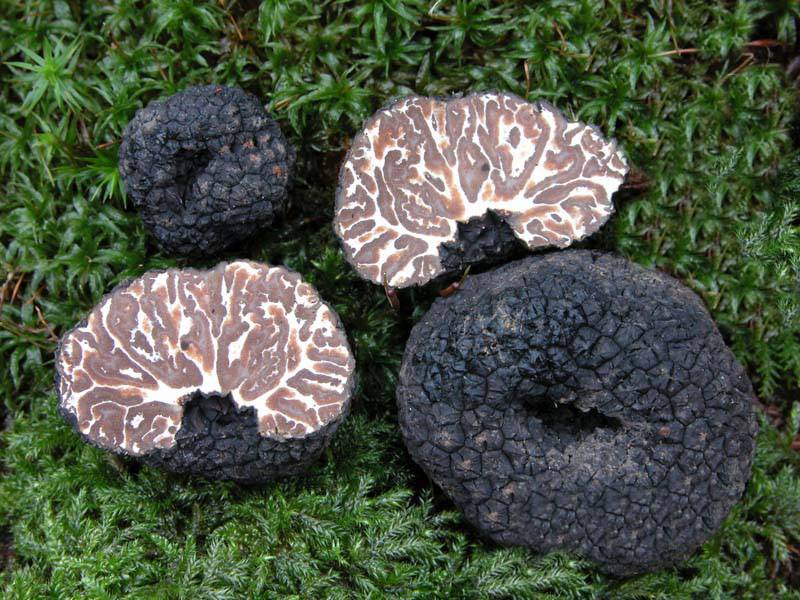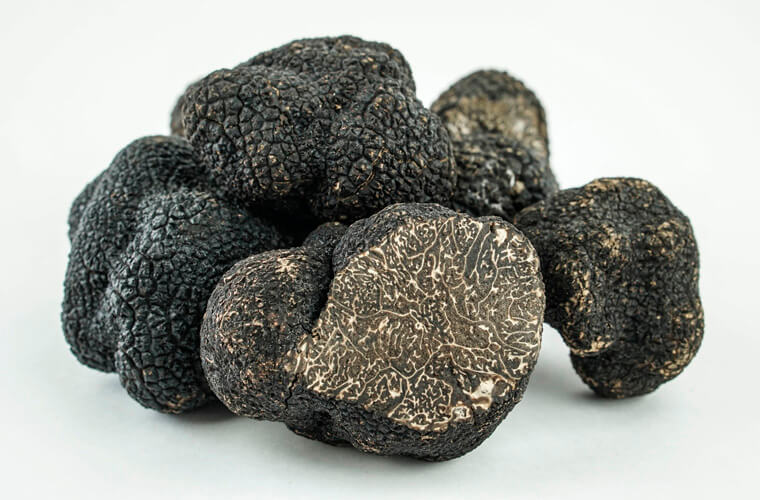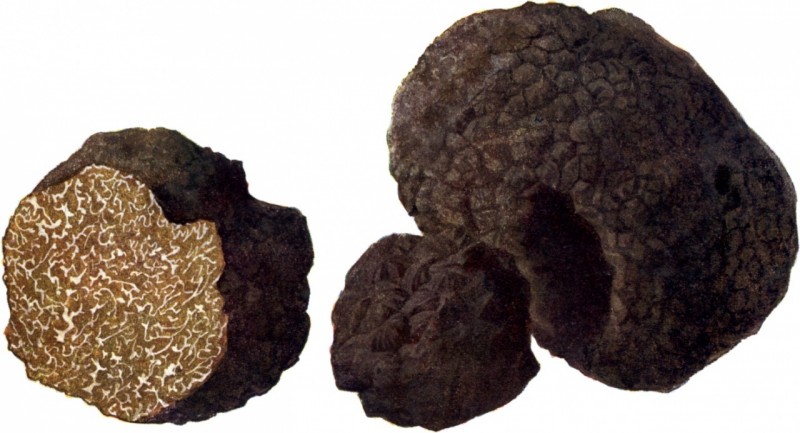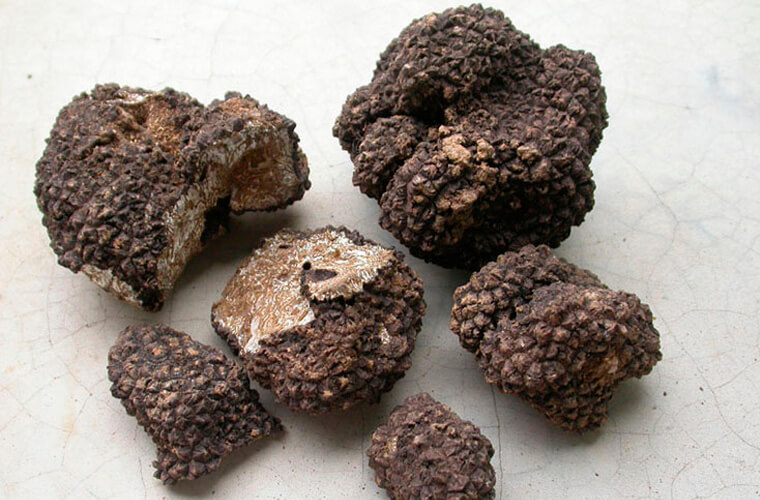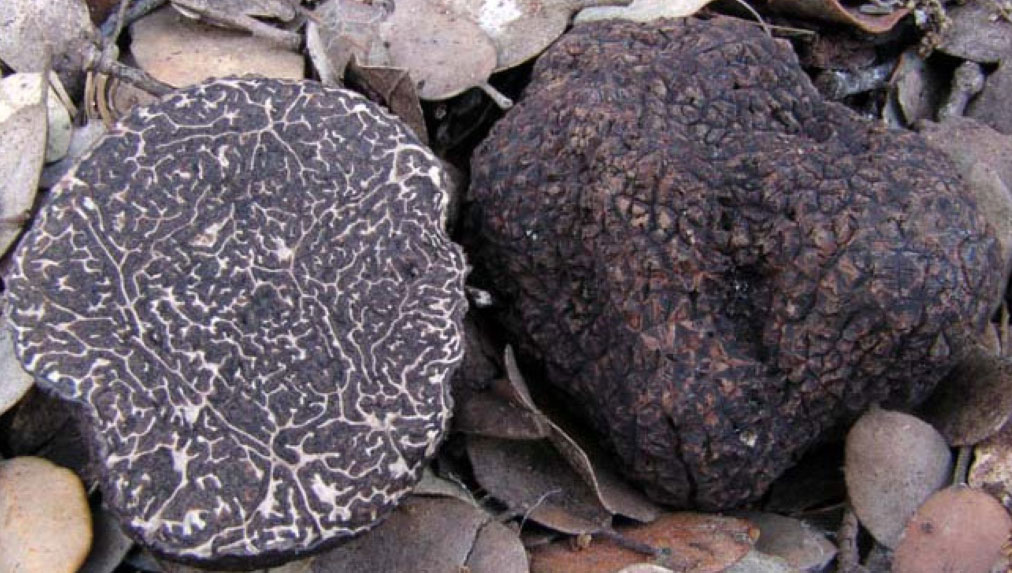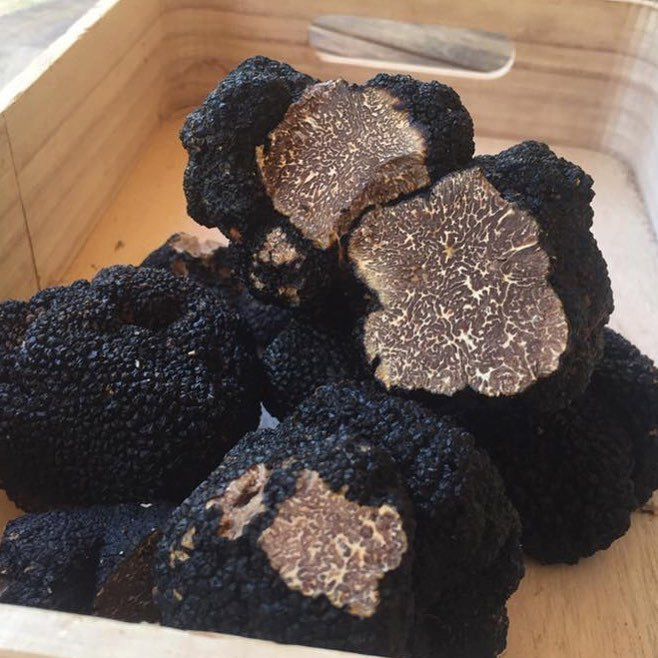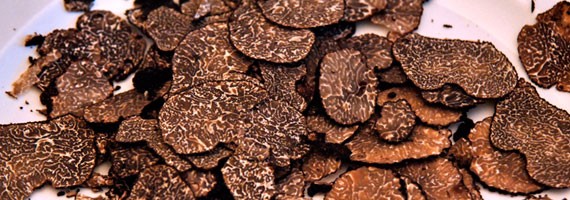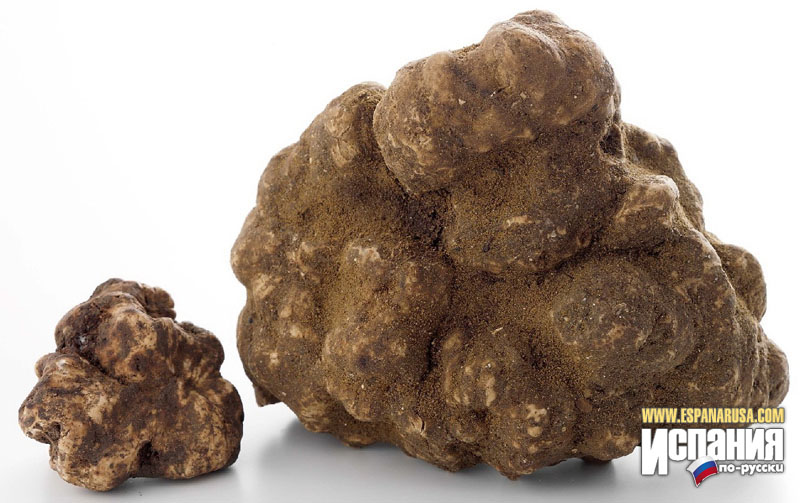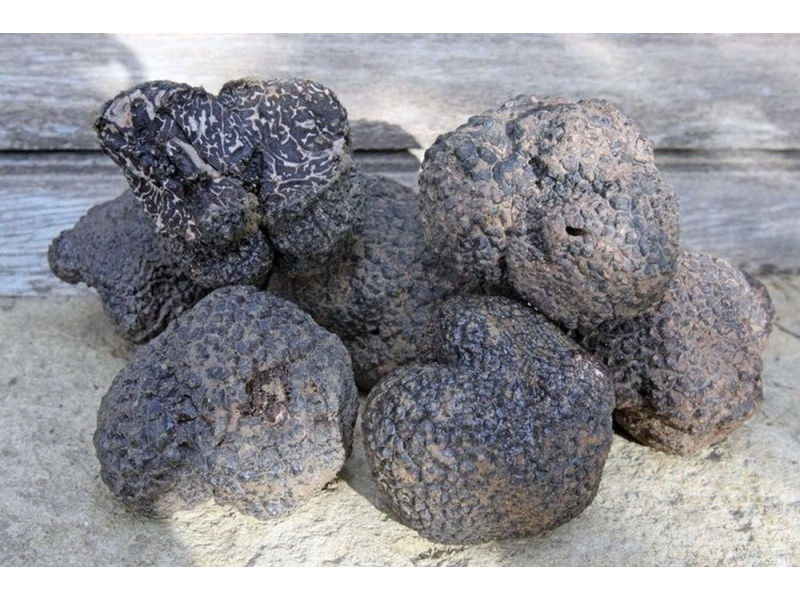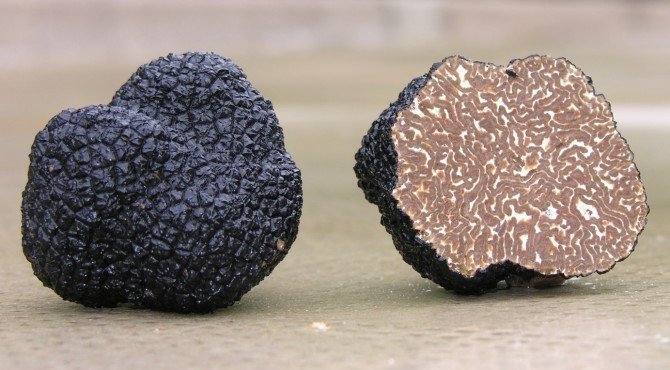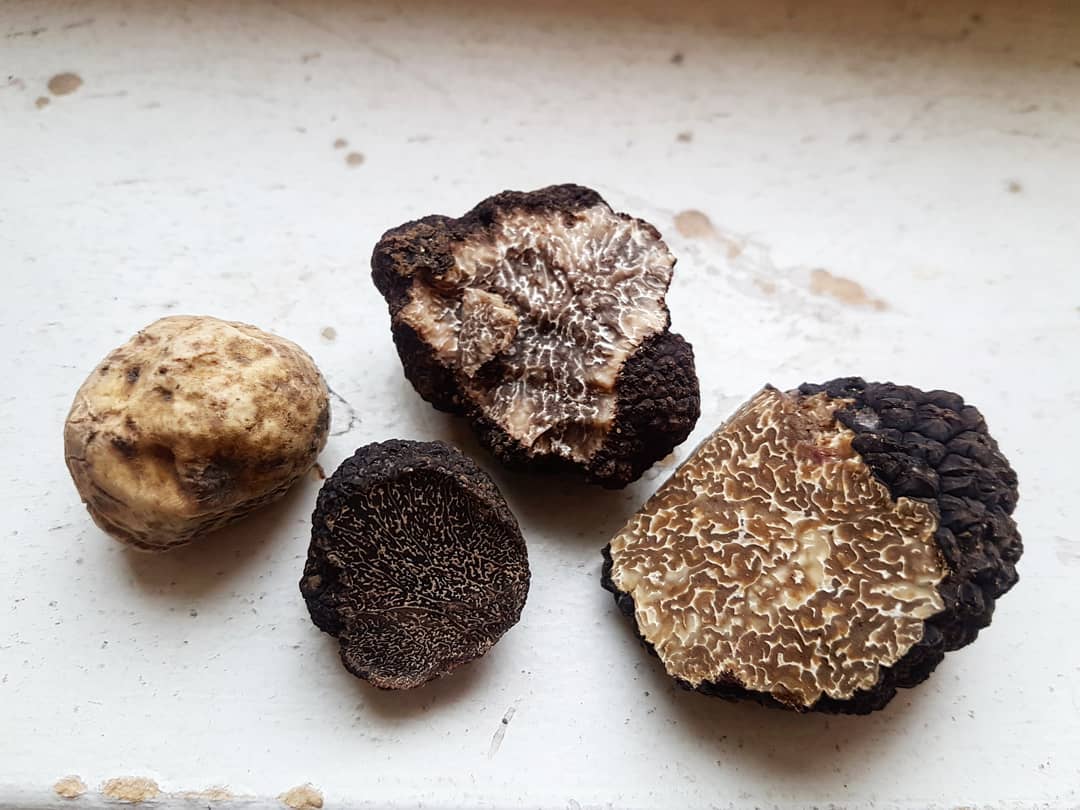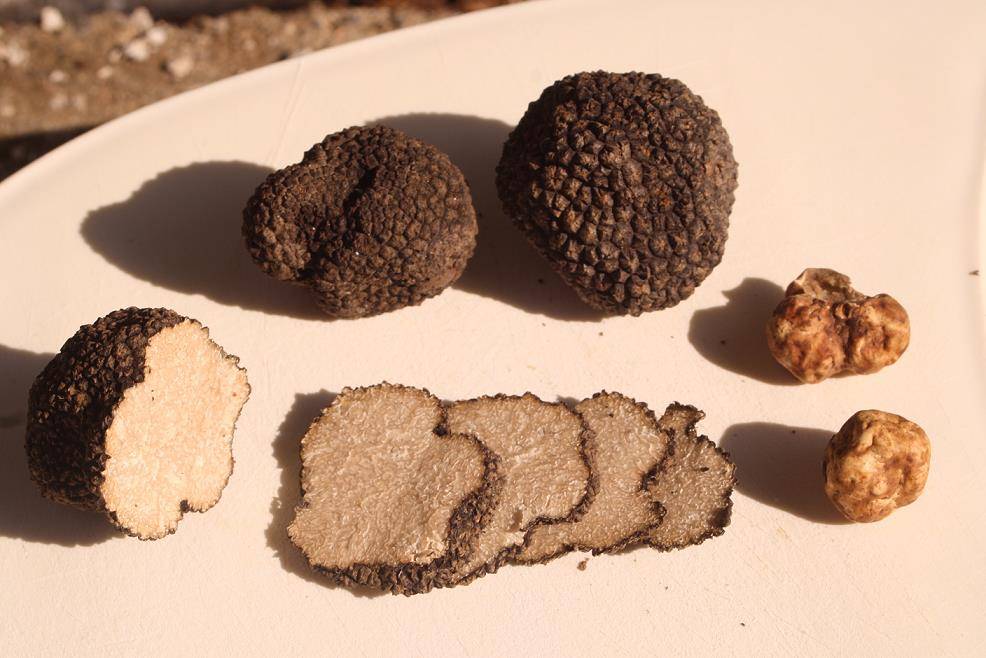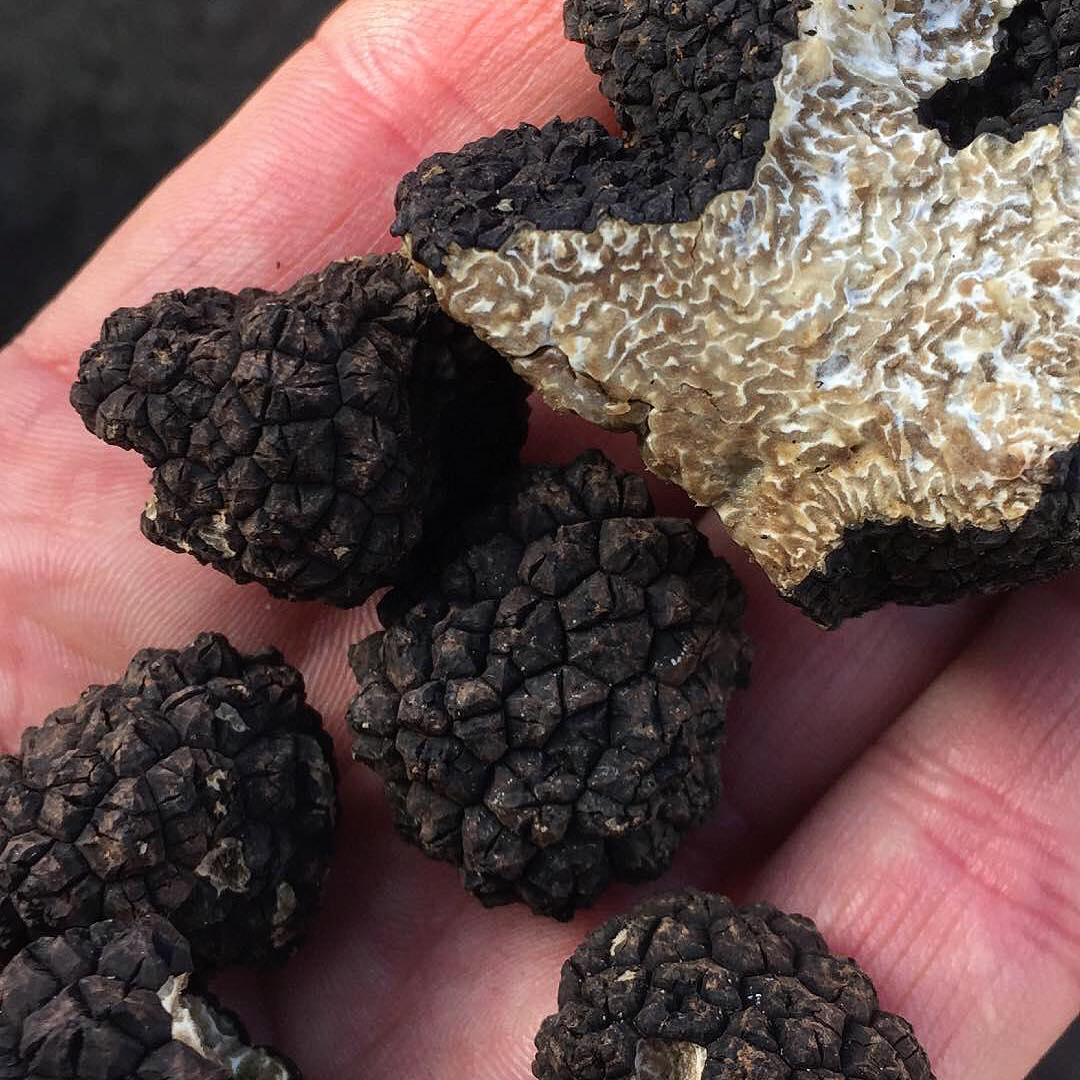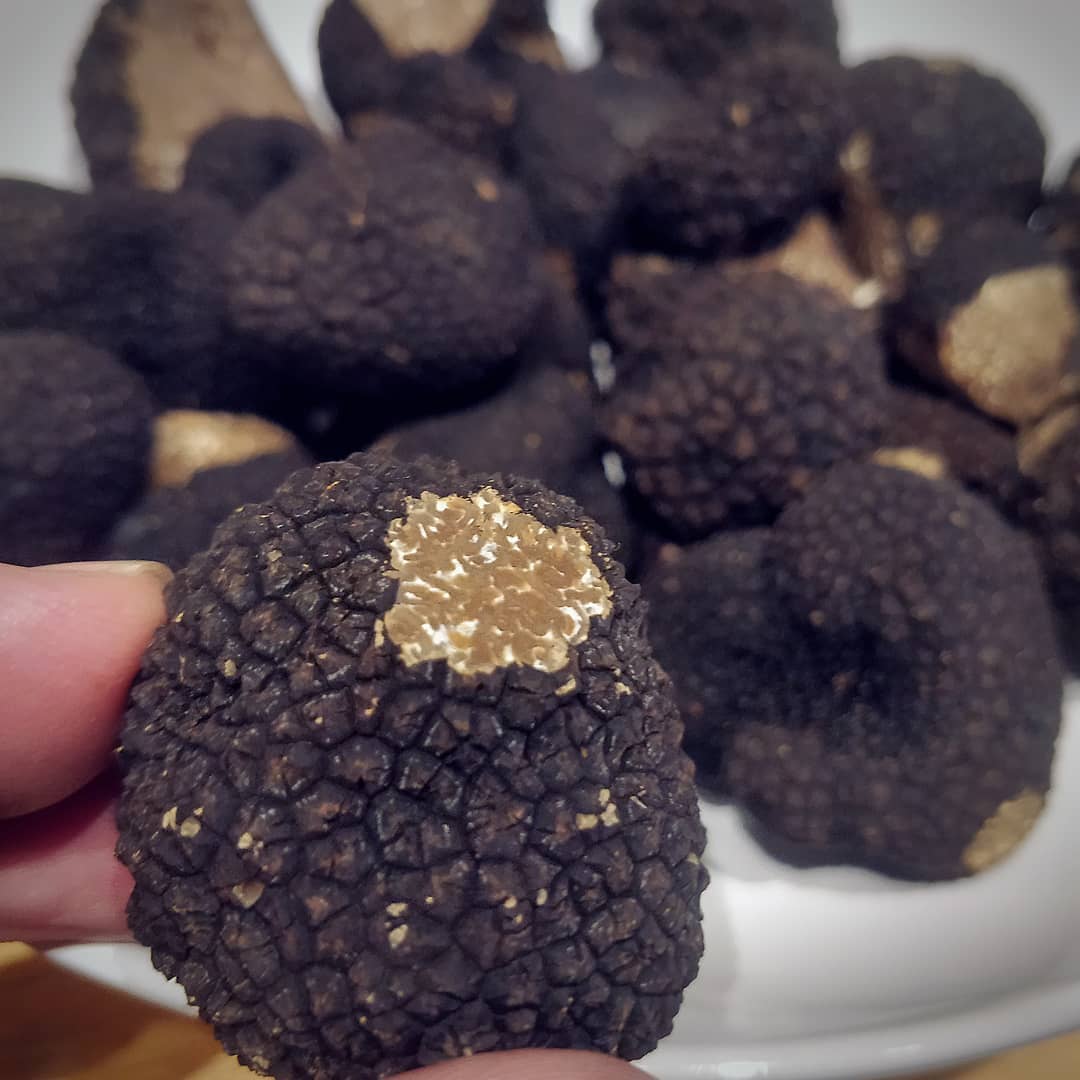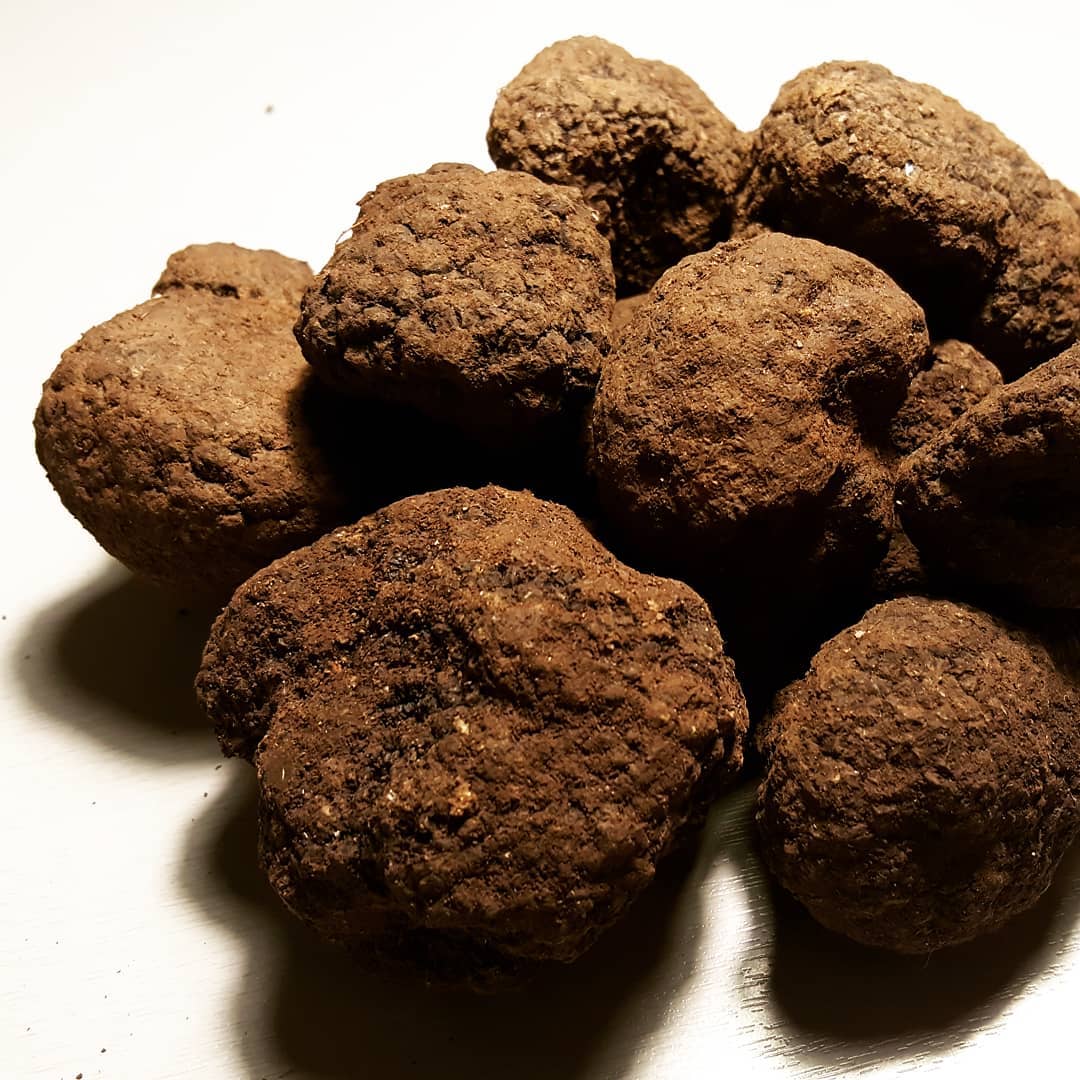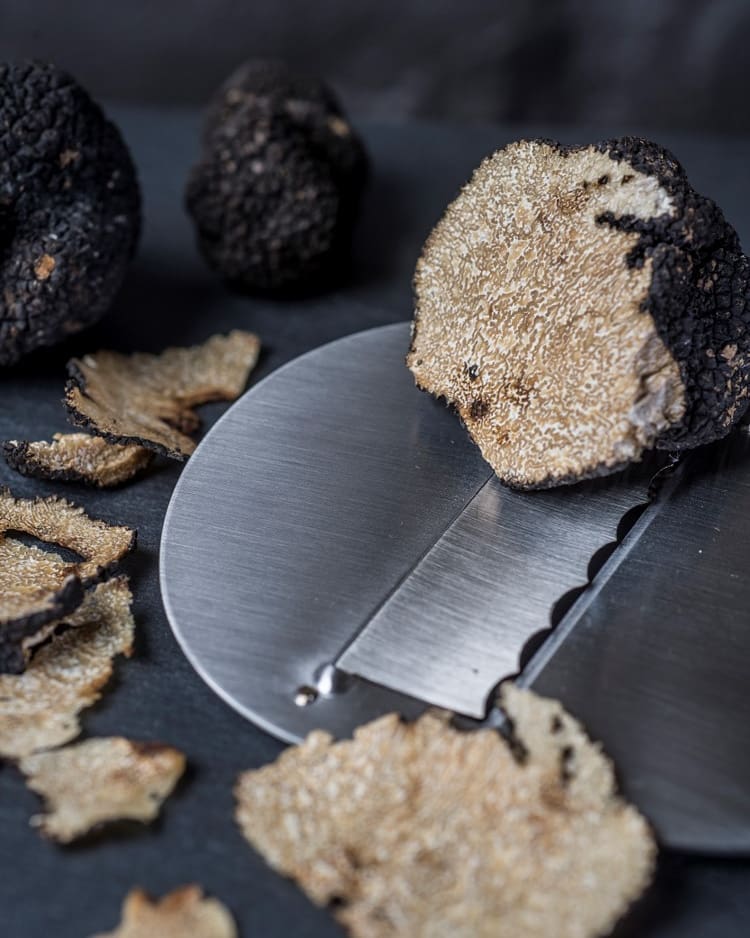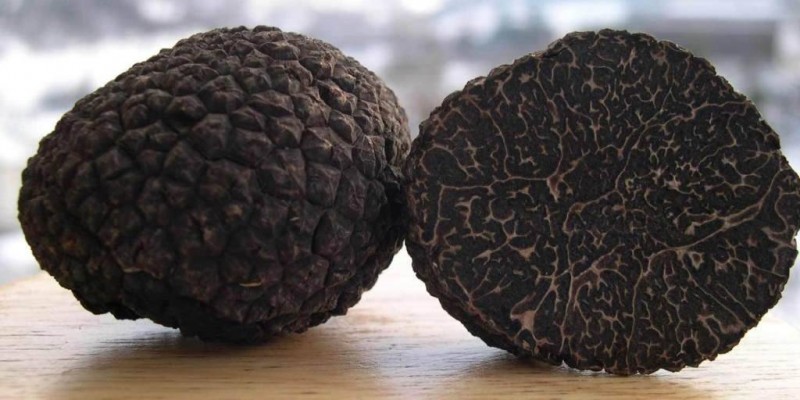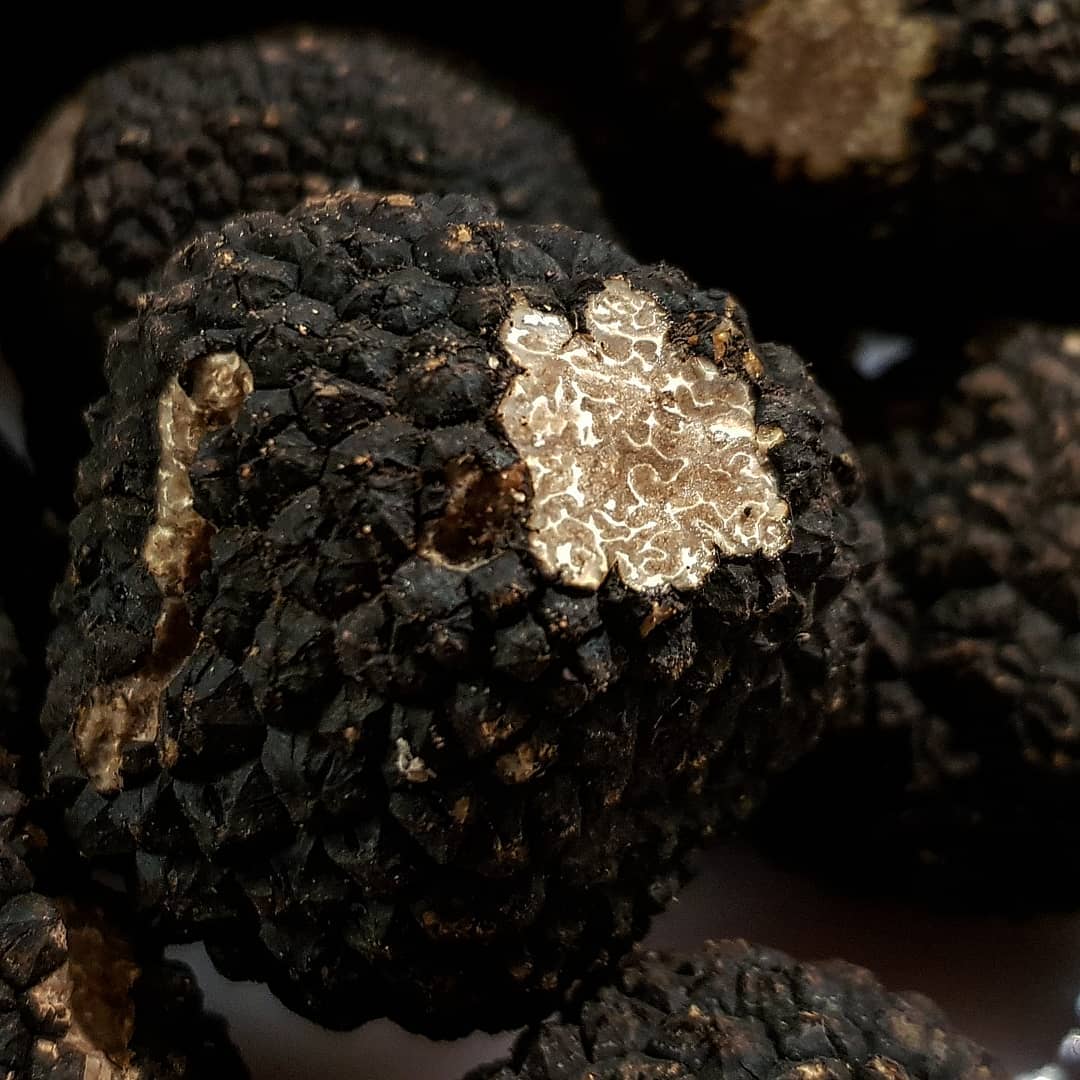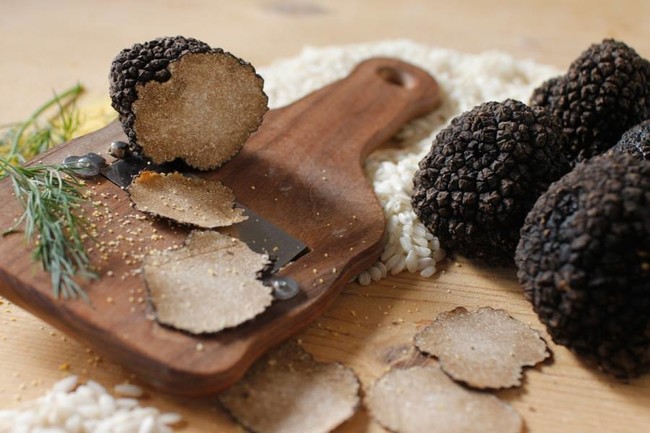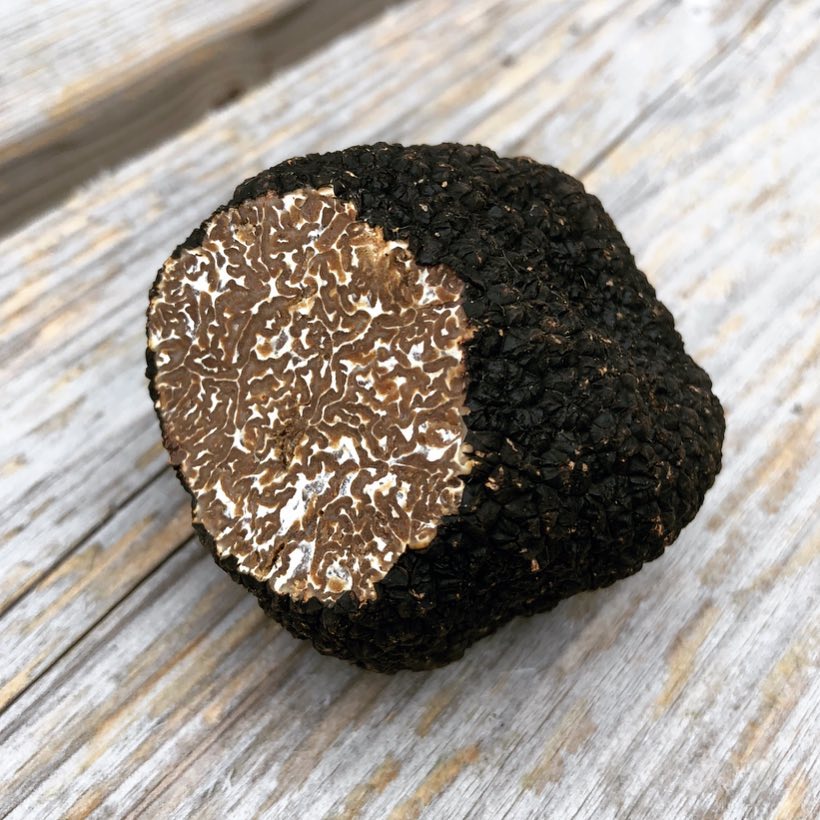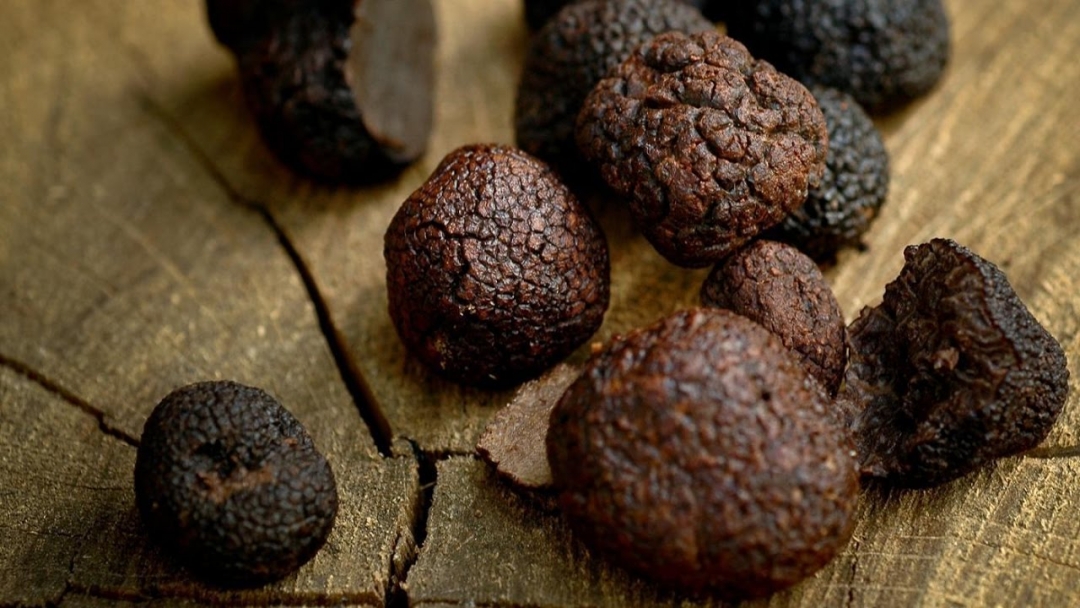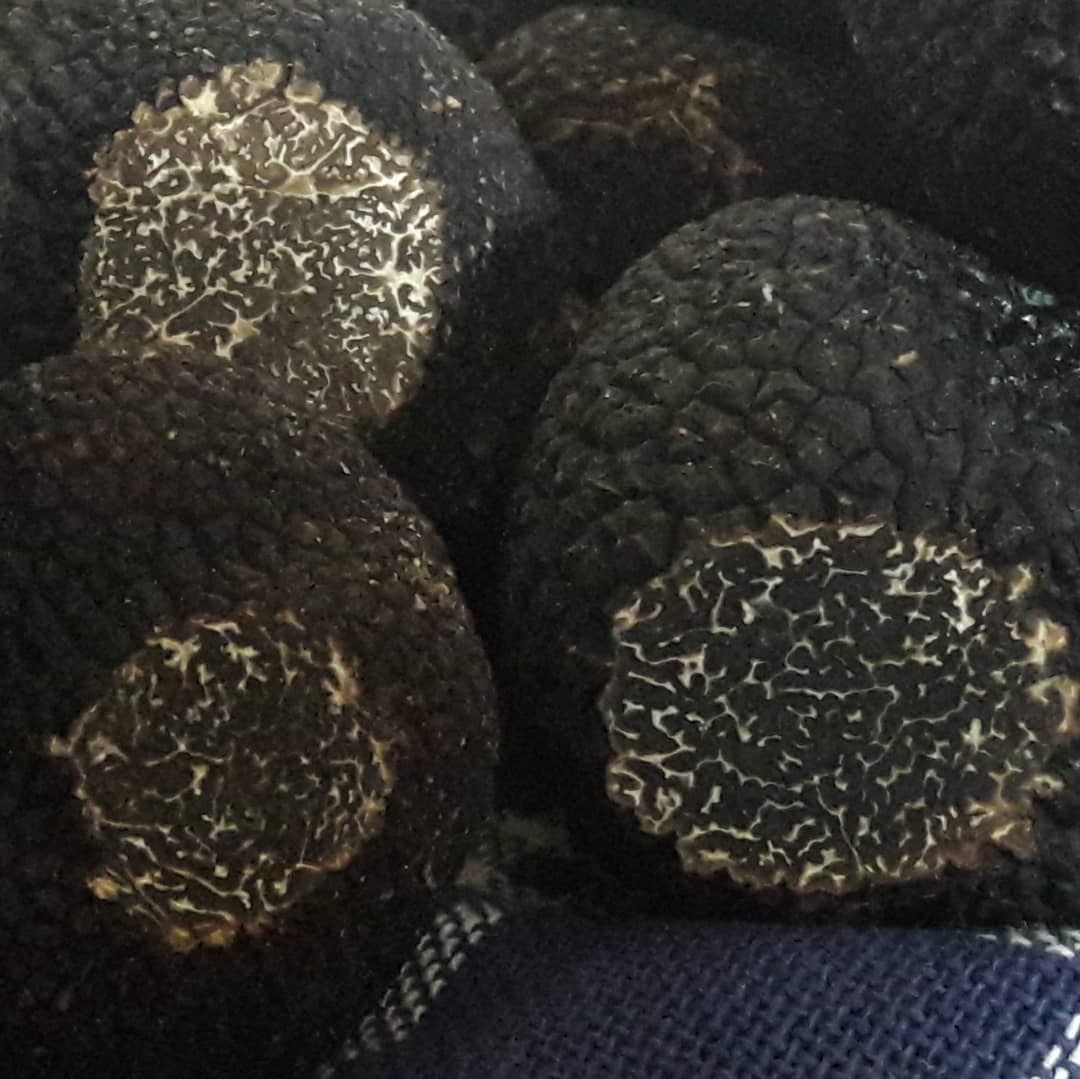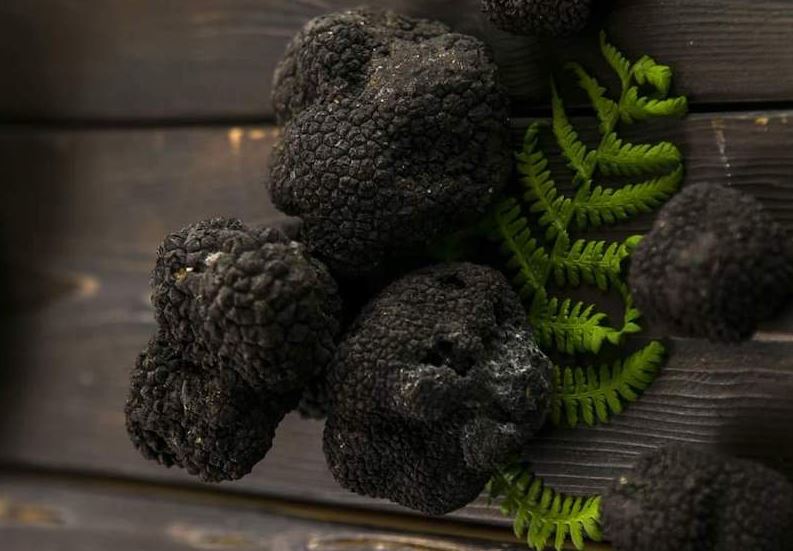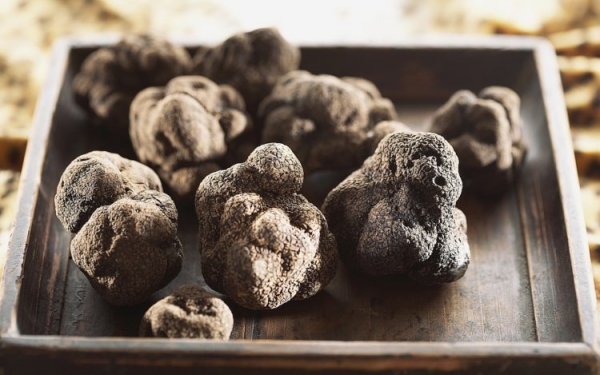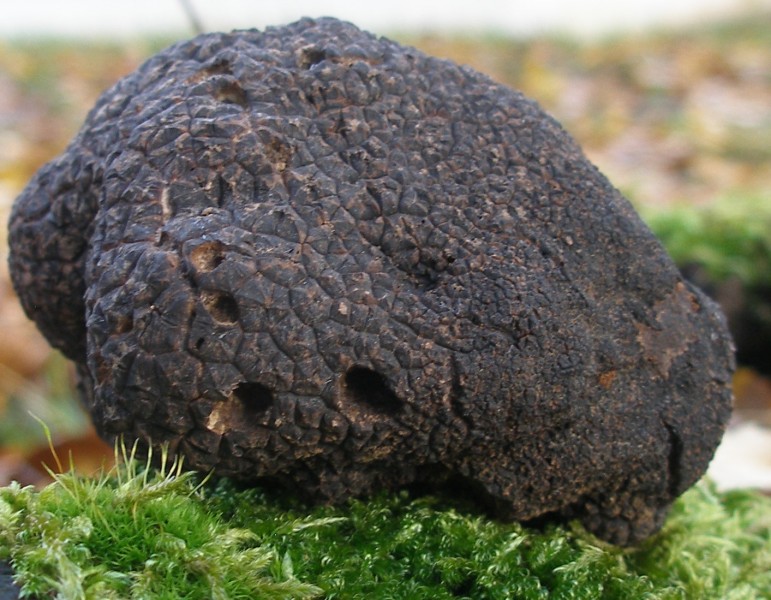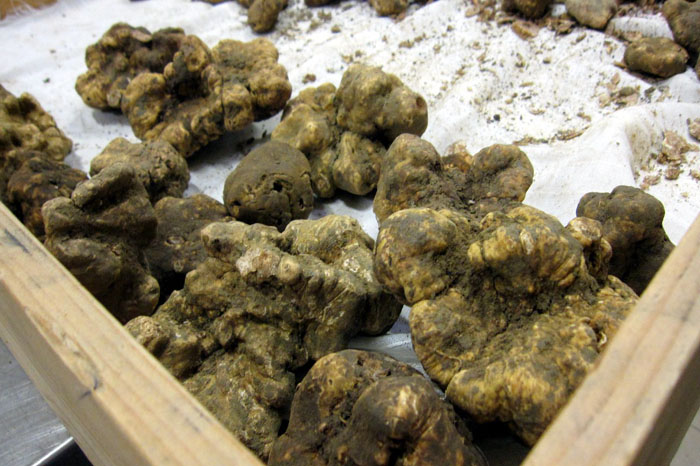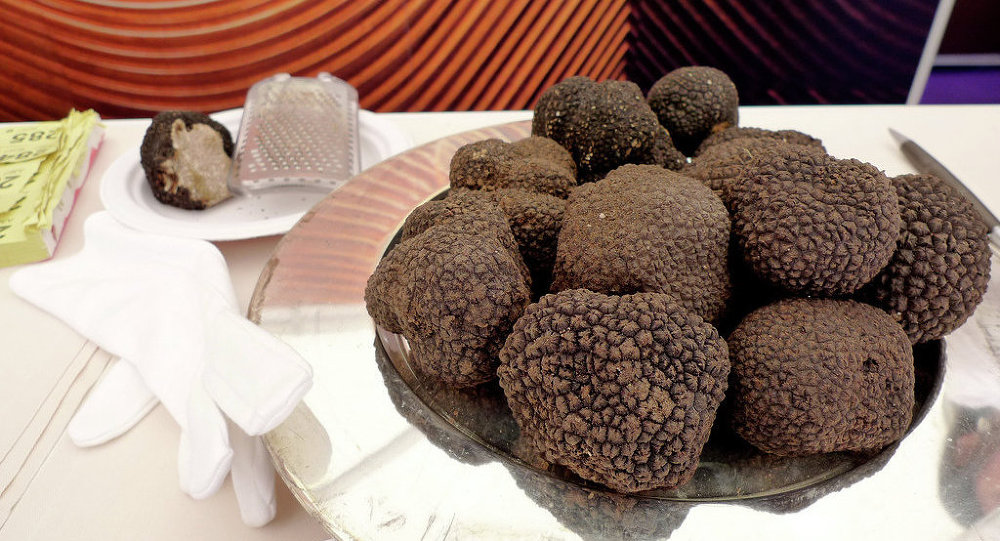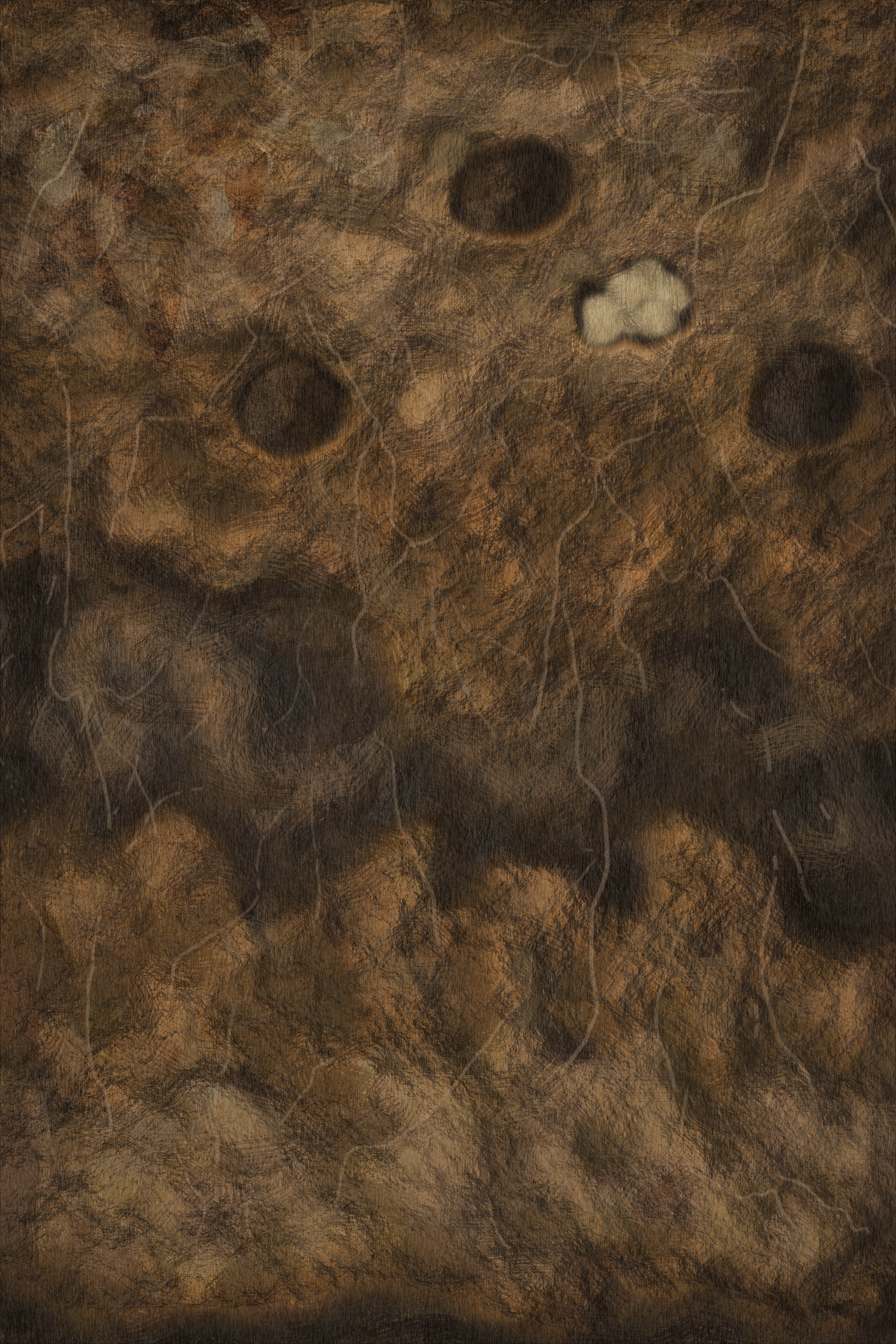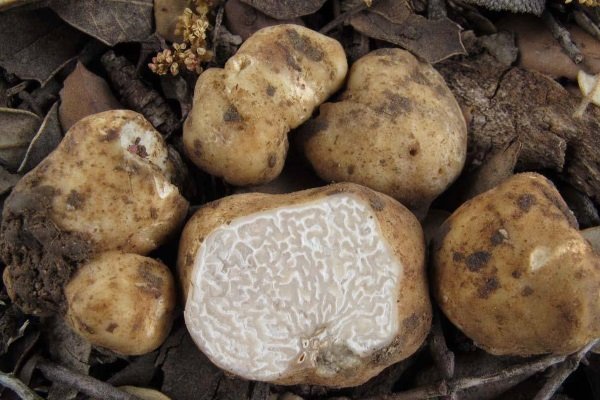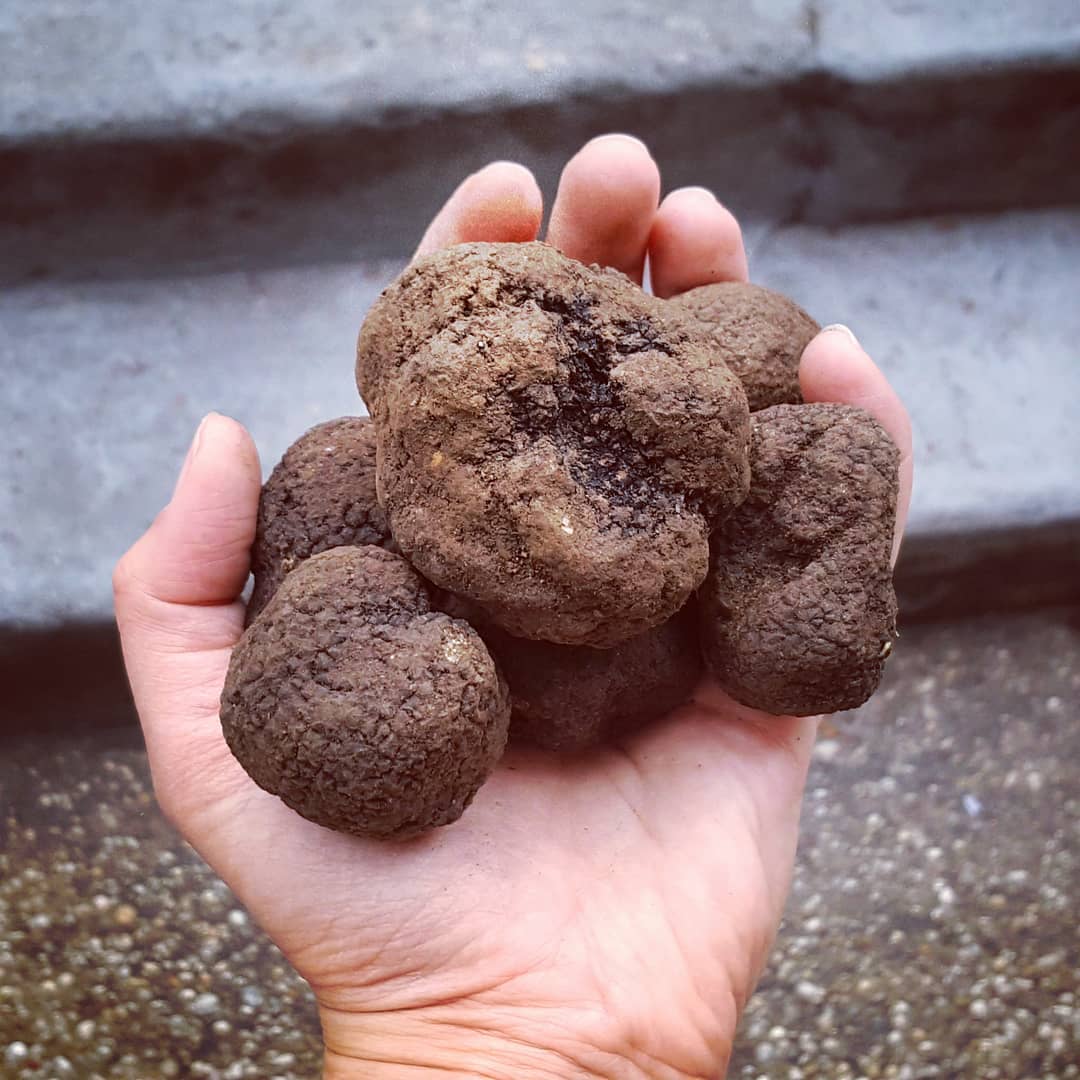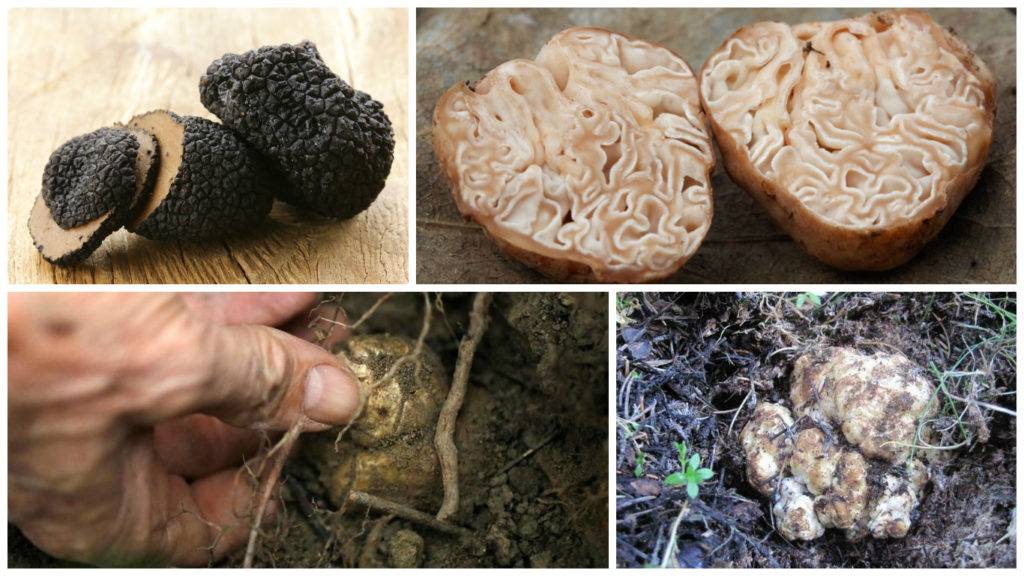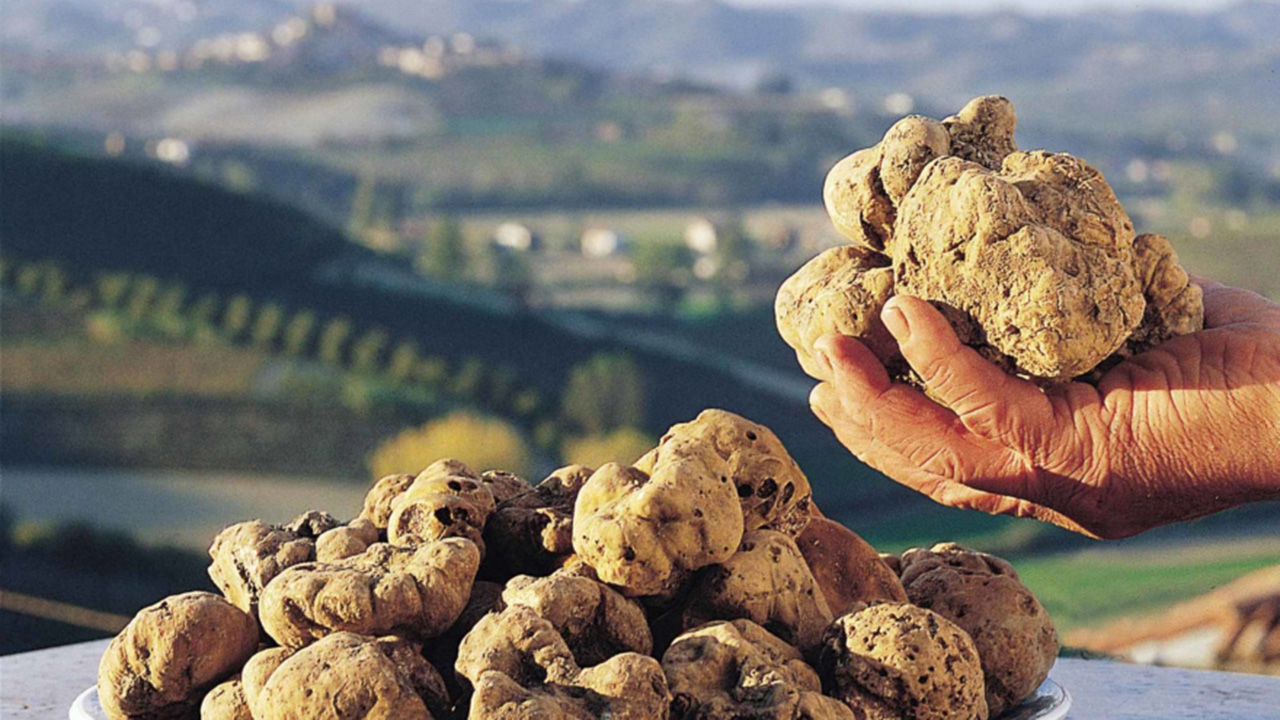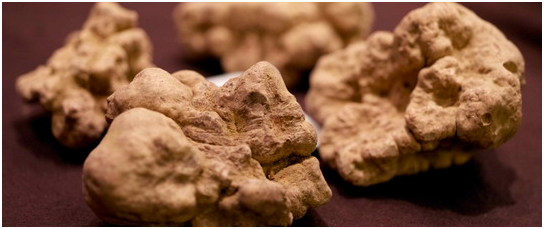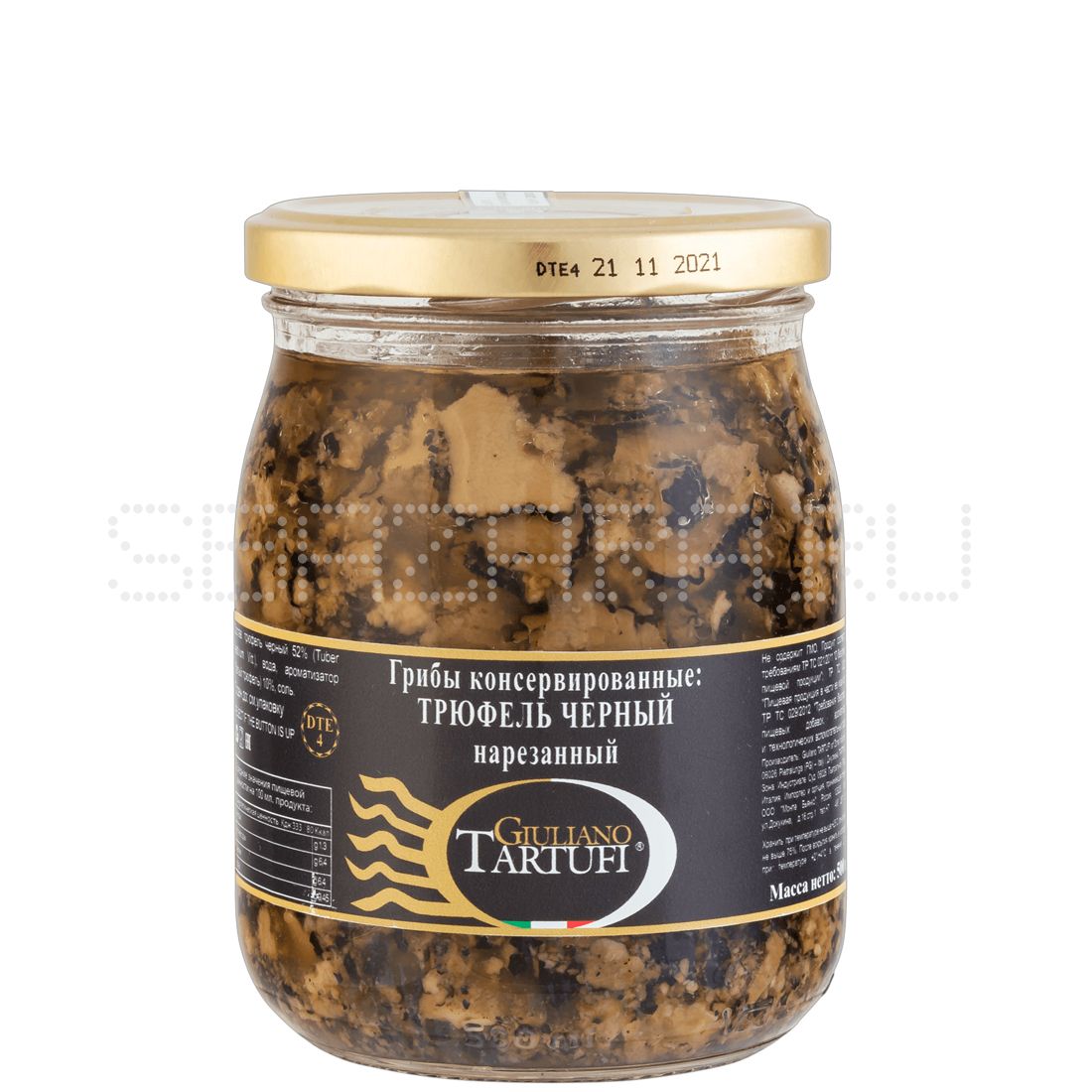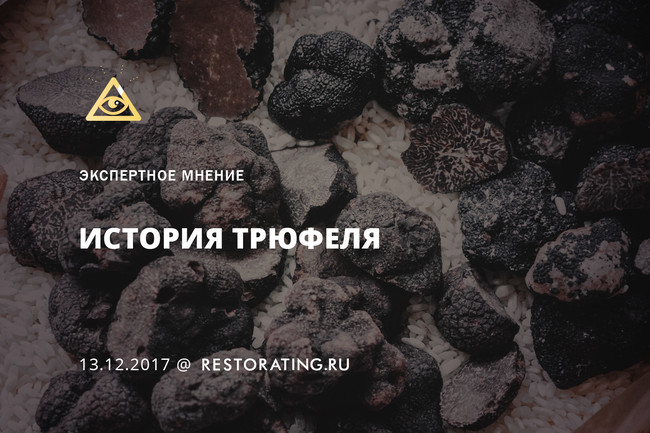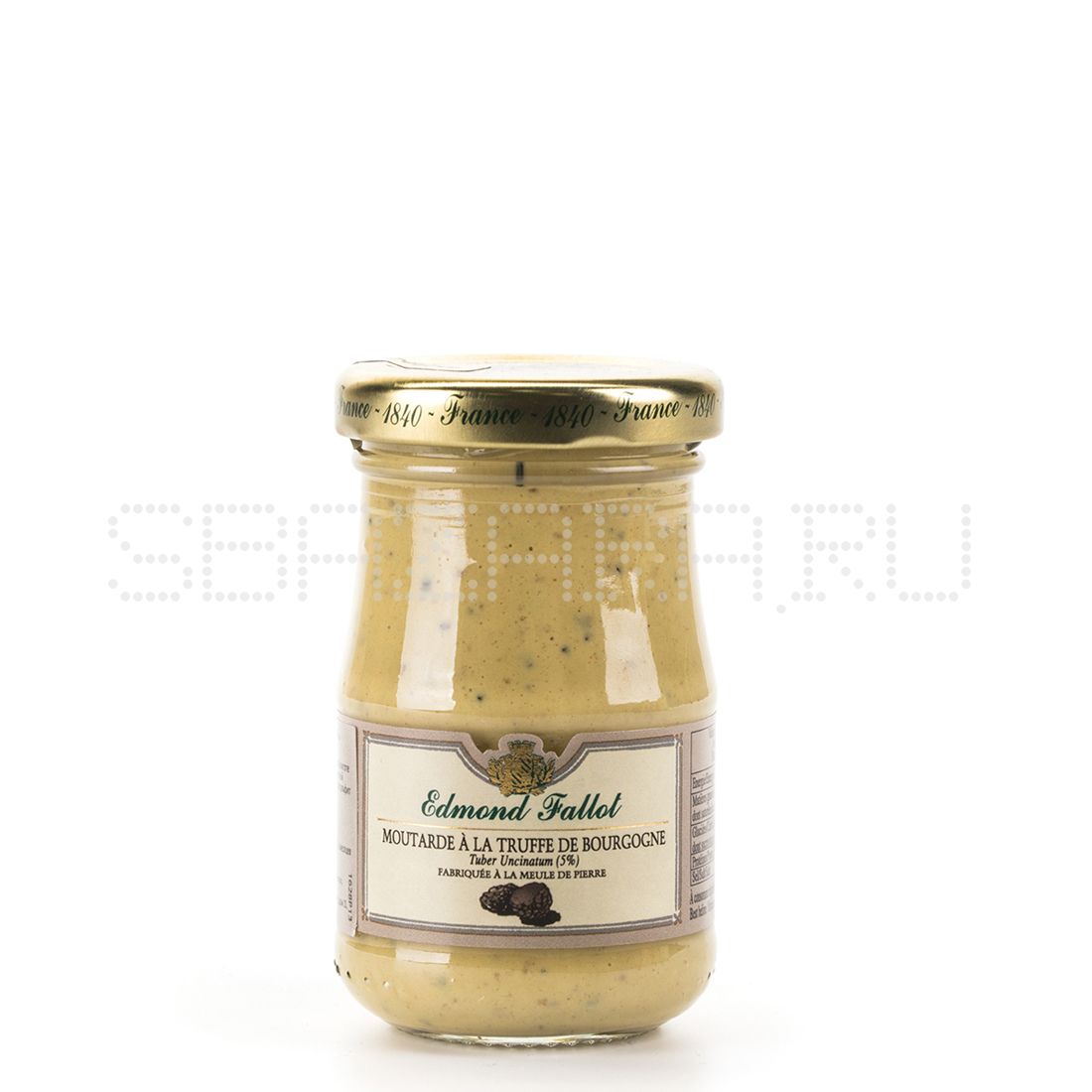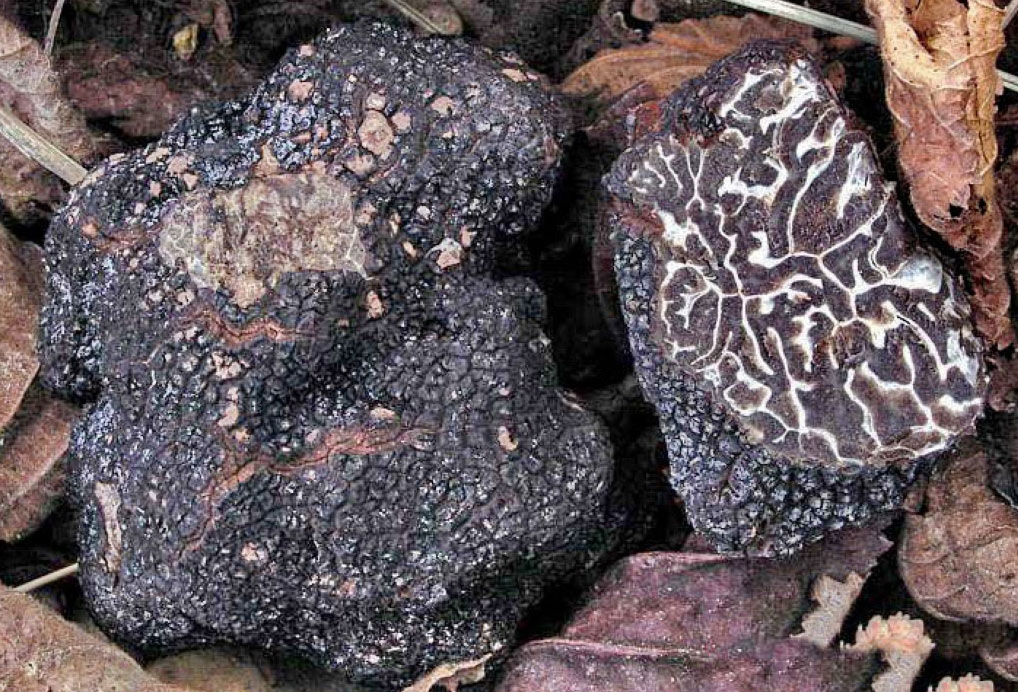Do truffles grow in Russia
The Russian truffle is called the black summer mushroom - Tuber aestivum (from Latin). They reach a diameter of 10 cm, weight is 400 g. Age is determined by the pulp: its color is whitish, yellow-brown, gray-brown. When ripe, the fruit body changes its consistency: it is dense in young mushrooms, and loose in old ones. The taste of the truffle is a little sweet, the aroma is reminiscent of hazelnuts, algae. There is a delicacy in Europe, the western part of Russia, under the pines, hazel, oak. The fruits can be found from June to October.
Black summer (Tuber aestivum)
This type of fruit is usually called saint-jean, scorzone, edible, burgundy. The ripening period lasts all summer and ends in late autumn. The northern regions of Russia differ in a different time of fruiting - from mid-summer to November. Tuber aestivum is found at a depth of 3-15 cm. Fruits are arranged in groups or singly, form mycorrhiza with beeches, oaks, hornbeams, rarely located near birches and pines. They are often found in southwestern Russia, on the Black Sea coast.
Winter black
The fruit is covered with warts 2-3 cm in size, its diameter reaches 20 cm. Fresh fruit has a reddish-purple hue on the outside, after collection the color darkens and turns black. The flesh of the truffle is white, then turns gray and becomes gray-violet with many white, yellowish veins. The mass of such a fruit can be more than a kilogram. It often grows in Ukrainian, French, Italian lands. Ideal places for plants are birch, oak groves, beech forests. Active fruiting - from November to March. The aroma of the truffle is reminiscent of musk.
White truffle
The price of the product is much higher than the previous ones. It resembles Jerusalem artichoke tubers 5-15 cm in size. Weight can be more than 1.5 kg. If you go for mature truffles, then keep in mind that the surface of the mushroom is felt, in young specimens it is even. When ripe, pits and protrusions appear outside, the color becomes light brown, yellowish. The pulp is white, in old fruits it is grayish with yellowish veins. Mushrooms have a nutty aroma. The older the fruit, the stronger the smell. "Tubers" are found in the Vladimir, Smolensk, Kuibyshev forests from late July to early November.
Growing at home
Difficulties in finding truffles forced experts to raise the issue of their artificial cultivation. For several centuries, all attempts were unsuccessful, but at the beginning of the 19th century it was successfully cultivated. However, only “black” species grow in an unnatural environment, “white” cultivation truffles are not served.
The main condition is a favorable climate. It should be moderate, warm, without sudden changes in temperature. Regions with hot summers and frosty winters are not suitable for this purpose. Seed material is best bought in a specialized store, but they are not cheap. Usually spores are grafted onto the roots of hazel or oak seedlings.
You can try growing mycorrhiza yourself. Beech or oak sawdust is infected with mycelium and placed in a warm, sterile place until mycorrhiza forms, but this will not happen until a year.
They select a place for planting trees - protected from the wind, direct sunlight, other shrubs, trees, flowers should not grow on its territory. Especially spruce, chestnuts and poplars do not tolerate truffles next to them. The place is protected from the invasion of animals. Truffle loves alkaline soil, if it is acidic, then add lime. And also it should be rich in humus, calcium and saturated with air.
Saplings are planted in the spring. The soil is not pre-fertilized so that the mycelium does not die. It is cleared of weeds, stones and dug holes 75 cm deep, watered. Then the seedlings are planted, covered with soil and watered again.At a distance of 40 cm from each seedling, the ground is mulched with last year's oak leaves. The temperature should be in the region of +20 ° C ... + 22 ° C.
It is recommended to fertilize with potash and nitrogen fertilizers. They are added not to the place where the mushrooms are planted, but to the ground near the roots of the tree where they grow. For the winter, they must be mulched to protect them from frost. In the spring they are fed with mineral fertilizers rich in boron, copper, zinc, calcium and iron.
The timing of harvesting depends on the type of mushroom planted. They hide at a depth of 20 cm from the surface. If the mushrooms rot or lose their nutritional value, then they may be located close to the surface. In this case, it is recommended to sprinkle the surface with clean dry sand. The truffles are dug out with a small spatula. Mushrooms grow not only near the roots of trees, but also are located between them.
Growing a truffle in a greenhouse or basement is expensive. To create optimal conditions, a system of air humidification, heating, ventilation is installed, special soil and means for additional disinfection are purchased. These costs will pay off if truffle cultivation becomes your business.
How to find truffles
To find a truffle in the forest, you need to have special knowledge. They are found near the roots of trees: they are often found near oak trees. Try not to look for fruits in the clear cut areas. Based on practice, such areas are not distinguished by a large number of mushrooms. It is desirable that there be black soil with high humidity. Before starting your search, consider the following:
- Consider the fruits in advance, live or in photographs.
- Prepare to search for animals: Specially trained pigs or dogs will do.
To make the "quiet hunt" successful, be guided by some features of the area. The rules for mushroom pickers are as follows:
The "truffle" area, where the delicacy is located, is distinguished by stunted vegetation, gray-ash soil.
Fungi rarely come to the surface of the soil (sometimes this happens due to strong winds or heavy rains), so look for them in the ground at a depth of 10-15 cm.
Pay attention to the bumps, they should be excavated.
Midges often circle over a place with mushrooms: the larvae feed on mushrooms, so the insects lay eggs nearby.
Growth features
A favorable place for the development of truffles is a large number of tree roots and soil with loose soil with a lot of sand and lime. Experienced mushroom pickers say that if they find one specimen, then you need to continue looking for several more nearby. Typically, you can find about 5 pieces. Truffle often develops in families, rarely singly.
Searching for truffles in the forest
People have been collecting unusual mushrooms for many years.
It is important to consider that there is a false and real mushroom. To return home with the desired prey, it is important to follow a special technology:
- Go to the forest where there are beeches, birches, oaks, hazel.
- Look for fruits near trees with large roots.
- If the search is carried out with the help of pigs, then they should be muzzled, because animals love to feast on mushrooms.
- Keep in mind the appearance of the plant: its surface is rough, the flesh is firm. The fruits resemble black or white potato tubers.
Truffle hunting animals
Mushrooms have a very strong odor that animals can easily pick up even at a distance. For this reason, experienced mushroom pickers prefer to keep specially trained dogs or pigs. The latter are able to smell at a distance of 25 meters. After the aroma is determined, the pig will actively dig up the delicacy. If there is no muzzle, then it is necessary to ensure that the pig does not eat what it finds.
As for dogs, they are indifferent to eating treats, so it is not necessary to wear a muzzle before searching. Before using these four-legged "detectives", it will take a long time to learn the rules of finding mushrooms.The dog needs to be trained to smell. If you are thinking of buying a trained dog, then keep in mind that it costs more than 5000 euros.
Taste qualities, medicinal properties, benefits and possible harm
The scent of a truffle delicacy is similar to that of algae or fallen leaves. Its nutty sweetish taste is appreciated by gourmets somewhat less than other types of truffles.
In cooking, these mushrooms are used to make sauces, pates, pie fillings, as a seasoning for seafood and poultry dishes. Occasionally they are served as an independent dish, as well as canned in cognac or frozen.
Eating a truffle is very beneficial:
- It contains carbohydrates, vegetable proteins, fiber, vitamins C, PP, B, antioxidants, various minerals, pheromones that improve mood.
- Its juice helps with eye diseases.
- The pulp of the mushroom can relieve gout pain.
Anyone who is not allergic to penicillin can eat truffles.
Primary processing and cooking recipes
The truffle is not subjected to heat treatment, it is used fresh in dishes with a weak aroma. Before use, the fruit bodies are washed from the ground with a brush, then cut into very thin slices or shavings, and spread on a ready-made hot dish. Under the influence of heat, the aroma of the mushroom is revealed more strongly.
Tuber Aestivum Extract in Cosmetics
Due to the presence of minerals and amino acids, Tuber Aestivum Extract is highly valued in cosmetology and is one of the most effective and expensive ingredients. Its active ingredients help:
- in the fight against wrinkles;
- improve complexion;
- remove swelling and redness;
- restore the skin after peeling and plastic surgery;
- stimulate the production of elastin and collagen;
- heals the hair structure and activates its growth.
With the participation of the extract, products are produced for the care of the skin of the face, hands, body (creams, serums, foundation, oil ampoules, moisturizers) and hair (shampoos, balms, masks). The main advantage of such cosmetics is safety and naturalness.
Features of the mushroom
Truffles are unusual, first of all, in that the fruit bodies are formed not on the ground, but inside it. Rounded or tuberous mushrooms have a fleshy and cartilaginous consistency. Their peculiarity is the marble pattern - the alternation of light and dark streaks on the cut. Light veins are called internal veins, and dark veins are called external veins. Spore sacs form on the internal veins and are also distributed by nests in the fruiting body. Mushrooms grow to different sizes. They can be the size of a walnut or potato tuber.
Young mushrooms have a smooth whitish skin that turns yellow over time and becomes light brown. The surface is covered with various folds, cracks and hard "warts". The yellow-whitish dry pulp with numerous brownish veins-convolutions turns brown when heated, and acquires a chocolate hue.
Truffle is an edible mushroom of the first category with the best consumer and culinary qualities. They are most often used fresh for making aromatic soups, sauces and gravies.
This is interesting: Levisia - planting, caring for and growing a flower in the open field from seeds at home
Truffle varieties
In total, about 70 varieties of truffles are known, but less than ten have at least some culinary significance. The most popular truffles - black perigord and white - have become such not only because of the richest taste (in this parameter, Burgundy and musky are comparable to them), but also because they give the largest specimens: an average black winter truffle is usually three times more summer. With the complexity of collecting even artificially cultivated mushrooms, this parameter becomes of great importance.
| TITLE | REGION OF DISTRIBUTION | SEASON |
| WHITE TRUFFLE TUBER MAGNATUM PICO | Mainly in northern Italy (Piedmont, Emilia-Romagna, Tosnana and Marne) | October - end of December |
|
BLACK PERIGORIAN OR BLACK WINTER TRUFFLE TUBER MELANOSPORUM VITT |
France, Spain, Italy and Croatia. Truffles from Perigord and Umbria are considered the best. Artificially bred in many countries from Sweden to New Zealand |
December-mid-March |
| SCORZONE, TRUFFLE SAINT-GENE OR SUMMER BLACK TRUFFLE TUBER AESTIVUM VITT |
All alpine countries in Europe |
Aug. Sept |
| BLACK BURGAND TRUFFLE IS SOMETIMES CALLED THE SUMMER BLACK TRUFFLE TUBER UNCINATUM |
France, Italy, Turkey, North Afrina |
September-December |
|
BLACK MUSK TRUFFLE TUBER BRUMALE |
Central and Southern Europe | November-mid-March |
Where does truffle mushroom grow in Ukraine
On the territory of Ukraine and Russia, only the summer variety grows, and in Russia there are much more areas of its growth than in Ukraine.
Summer species can be found in glades or oak forest edges. It is extremely rare to find them in copses, birch groves or aspen forest. In cross-section, they can resemble marble. The aromatic qualities are very strong, which is appreciated among culinary gourmets. However, aroma can be lost during prolonged storage.
Habitat
If you are interested in where the mushroom grows in Ukraine, we hasten to disappoint you: there are very few places for its growth.
The winter variety grows in the Right Bank and Western parts of Ukraine. But much more often it can be found in the mountainous part of the Crimea, as well as in Switzerland, France and Italy. Harvesting begins in November and lasts until March. The size of the fruit bodies can reach 20 cm, and the weight reaches 1.5 kg. The surface of the fungus is warty and the fruiting body itself has a musk smell, but it is not very pronounced.
In deciduous forests and on calcareous soil, you can also find a black summer variety. The size of its fruiting body can reach 10 cm, but it is not easy to find it, since it is located under the surface of the soil at a depth of 10-15 cm.
Areas where reindeer truffles grow.
Most often, reindeer truffles grow in pine forests, less often they settle in spruce forests, they can also be found in deciduous forests and parks. Reindeer truffles grow on sandy soil, they lie shallow from the surface - right under the forest floor, under a layer of needles or under moss.
They can be found at a depth of 1-16 centimeters, on average they occur at a depth of 5 centimeters. The mycorrhiza of the deer truffle envelops the roots of the trees, forming mycorrhiza with them. Many tree species are suitable for this.
On the Karelian Isthmus, these fungi are rare; they were found there only in abnormally warm winters. They grow in small groups and singly. In St. Petersburg, they also rarely come across, they were found in only one place.
Reindeer truffle doubles.
The deer truffle bears a special resemblance to its closest relative - the prickly truffle, which is covered with a yellow-brown warty shell. Thorny truffles grow under the birches.
There is also a slight resemblance to the small edible red-brown truffle, whose kidney or tuberous bodies reach 7 centimeters in diameter. Their surface is red-brown or pink-brown, and the flesh is cerebral, marbled-yellowish in color, fragrant.
Evaluation of the edibility of reindeer truffles.
These mushrooms are not eaten, but reindeer truffles are a delicacy for many forest dwellers - squirrels, badgers, deer, mice, wild boars, and so on. In years when seeds are scarce, squirrels often dig into the ground to find these truffles. They can smell mushrooms at a depth of 5-8 centimeters and even find them under the snow.
Northern hunters call these mushrooms "parushkas" or "pargas". They are the best bait for squirrels.
Interesting information about deer truffles.
Reindeer truffle is a marsupial underground mushroom. It has absolutely nothing to do with the real truffle, but these mushrooms were used as fake truffles. There are about 20 species in the genus that grow in deciduous and coniferous forests of Europe. And in our country, only 2 similar species grow.
Reindeer truffles are often parasitized by another fungus - the Cordyceps ophiroglossous. The black club-shaped bodies of this mushroom protrude from the ground, this indicates that there are deer truffles in the soil. Cordyceps ophiroglossous grows in pine, spruce and oak forests.
17 years after the Chernobyl accident, the Swiss Health Authority conducted a study that showed that in 2003, the myceliums of deer truffles contained an increased amount of radioactive cesium-137, and it entered the organisms of local wild boars.

